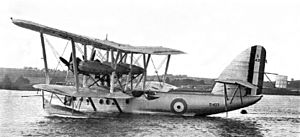Short Rangoon
| S.8/8 Rangoon | |
|---|---|
 |
|
| Role | Flying Boat |
| Manufacturer | Short Brothers |
| First flight | 24 September 1930 |
| Introduction | 1931 |
| Retired | 1935 |
| Primary user | Royal Air Force |
| Number built | 6 |
| Developed from | Short S.8 Calcutta |
| Variants | Kawanishi H3K |
The Short S.8/8 Rangoon was a 1930s British three-engined biplane flying boat, designed and built by Short Brothers for the Royal Air Force.
In 1929, the Royal Air Force needed urgent replacements of the Supermarine Southampton IIs then operated by No. 203 Squadron RAF based at Basra, Iraq. The Air Ministry issued Specification S.18/29 to specifically cover the procurement of a military variant of the Short S.8 Calcutta, similar to the S.8/2 Calcutta then being designed in collaboration with Breguet for Aviation Navale (French Naval Aviation). The new RAF version had Shorts designation S.8/8 and RAF designation Rangoon, and three examples were initially ordered.
The Rangoon was a straightforward military adaption of the Calcutta. The main structure was assembled from duralumin formers, spars, ribs and stringers; the fuselage was skinned with duralumin, and the flying surfaces were partly skinned and partly fabric-covered. The major changes were the provision of an enclosed cockpit for the pilots, rest bunks, enlarged fuel tanks in the upper wing, three Lewis guns (one mounted forward of the cockpit, and two in the fuselage behind the wings), underwing bomb racks, and a large fresh water tank (for intended use in tropical conditions).
On 24 September 1930, the first Rangoon (S1433) was flown from the River Medway at Rochester by Shorts' Chief Test Pilot, John Lankester Parker. In early 1931, the first three Rangoons were delivered to the RAF for training at Felixstowe, then in April 1931 they were flown in formation to No. 203 Squadron RAF at Basra. They were used for surveying and anti-smuggling patrols over Iraq and the Persian Gulf. Over the following three years, three more Rangoons (built to a higher specification R.19/31) were delivered to No. 203 Squadron at Basra, where they served without problem until 1935, when they were replaced by Short Singapore IIIs.
...
Wikipedia
